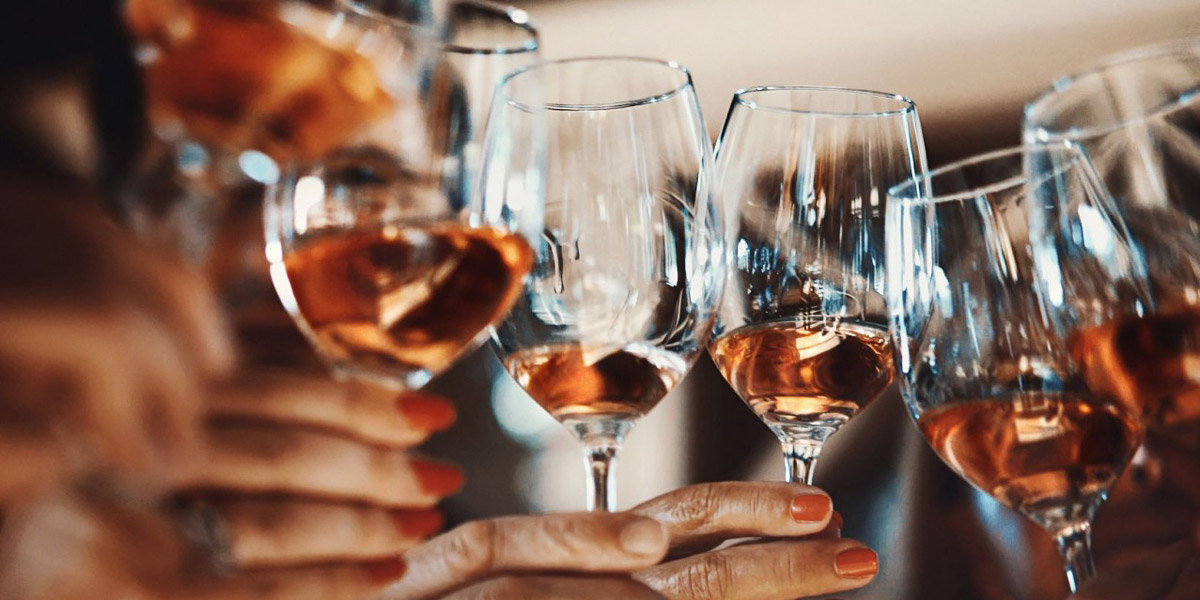Your cart is currently empty!
01 Mar Best tips for choosing a Rosé wine in a Dutch supermarket
I’m going to make you sing a bit with these simple words by Playahitty: “the summer is magic, is magic…” yeah, you feel it now, the summer is around the corner and when the temperature starts rising and the days are nicer and sunnier, it is rosé wine time!
But, how can I choose a rosé that fits my tasting profile? To answer this question you need to know the two things that have the most impact on the taste profile of a rosé wine (I promise I will not bore you with technical matters):
1. The grape variety. It will determine the aromas and flavours of the wine
2. The way the wine is made: It will determine the aroma, flavour and colour intensity of the wine and therefore, the style of the wine.
1. The grape variety
You can make rosé wine from any kind of red grape variety. This mean that the grape variety or varieties (yes, there could be more than one grape variety) will provide their signature flavours to the wine, but not as intensely as when you are making a red wine. For example, in Spain, it is very common to find rosé wines made from Tempranillo grapes, the same grapes that are used to make red Rioja wines. These wines will have the same aromas and flavours of red cherries, raspberries and strawberries, as a young Tempranillo wine, such as a Rioja Vino Joven, but with the difference that the rosé will be fresher and . Another example are the grape varieties Grenache and Syrah, most commonly used in Rosé coming from Côtes de Provence and Pays d’Oc in Southern France. The Grenache provides red fruit flavours, a bit of spices and medium to high levels of alcohol, while the Syrah contributes with medium to high levels of acidity in order to enjoy a refreshing well-structured, easy to drink rosé wine.
2. The way the wine is made
The way the wine is made will determine the style, aromas, flavours and flavour intensity of the wine. The two most common methods to make a rosé supermarket wine are:
1. Direct pressing method: This is the most common way to make rosé. Once the grapes are taken from the vineyard to the winery, they are crushed and pressed. The grapes’ skins are quickly removed to prevent them from adding more colour intensity aromas and flavours which would not suit this style of wine. Then, the juice is fermented at a low temperature and once the fermentation is finished, voilà! You made your rosé wine! The lack of skin contact produces rosé wines that are paler in colour and lighter in body. Also, the aromas and flavours are more delicate as they come straight from the grapes’ juice and a tiny bit from the grapes’ skin when pressed. These wines are usually more citric and green fruit oriented, displaying notes of grapefruit, watermelon and red apple, sometimes floral and spiced depending on the grape variety. Most Côtes de Provence Rosé wines are made using this direct pressing method. For example, the AH Excellent Selectie Côtes de Provence rosé (€ 8,29) has a pale salmon colour, a medium to high acidity, and has floral notes, as well as citric notes such as grapefruit and orange peel, watermelon, and wet stones (minerality). Most Côtes de Provence rosés are a blend (a mix of grapes varieties), with Grenache usually the dominant one, followed by Syrah and Cinsault. Each producer plays with the proportion of each grape variety in the blend to create their signature wine. They can even choose to make the wine with only two grape varieties, like La Tulipe Rosé (€ 6,49), which is made with Grenache and Syrah grapes. These grapes give the wine more of a fruity character, displaying notes of grapefruit, watermelon, strawberries and red apples. Both wines above have a lovely fresh acidity, making them very pleasant and easy to drink.
2. Short maceration: This is the second most common way to make rosé wines. It is similar to the direct pressing, except that the juice spends hours in contact with the grapes’ skin, adding more colour intensity, flavours and aromas. This is called maceration. Then, the juice is drained off the skins and it is fermented at a low temperature. Once the fermentation is finished, voilà again! Wine has been made! These wines are deeper in colour and they have more of a red fruit flavour than the direct pressing method and they tend to have more of a medium to full body, as tannins are being added to the wine (a wine natural chemical compound that provides structure to it). Here, the winemaker should pay attention not to add too many tannins during the maceration time, or else, the wine will have a bitter taste. Sometimes, maceration keeps going during the beginning of the fermentation and this extracts even more colour, flavours and aromas. For example, Los Molinos Tempranillo Rosado (€ 3,49) has spent between 4 to 6 hours macerating to create a lovely medium pink wine with aromas and flavours typical of a Tempranillo grape, such as strawberries and red cherries, with the addition of red apples. It is medium bodied and with a refreshing acidity that makes it very easy to drink and enjoy on a summer day. The price-quality relationship of this wine is surprisingly good. Another example of short maceration is the Echo Falls White Zinfandel (€ 4,99), a rosé from California, which is great for those who enjoy the sweeter rosé wines. The Zinfandel grape produces so much sugar that it can’t all be turned into alcohol. Therefore, some sugar is left in the wine, making it an off-dry, medium sweet wine. This wine has notes of watermelon, pomegranate, red cherries and strawberries. Its low acidity is well balanced with its low alcohol level, making it a nice wine to drink as an aperitif or with a fresh green salad.
My rosé recommendation for this summer
If you like more delicate, floral, citric, green fruit, lighter-bodied, less intense wines, choose a pale style of rosé, like a Côtes de Provence Rosé such as the AH Excellent Selectie Côtes de Provence rosé (€ 8,29) or the La Tulipe Rosé (€ 6,49)
If you like more intense, fuller-bodied, red fruit oriented wines, go for a darker coloured rosé, like the Los Molinos Tempranillo Rosado (€ 3,49) or if you like them dark but a bit sweet, then try the Echo Falls White Zinfandel (€ 4,99)
If you want to try something different, then, start playing using the criteria I pointed out in my last article (How to find a great wine in a Dutch supermarket) and enjoy your wine adventure!
Rosé serving temperature
The serving temperature for a Rosé is between 10ºC to 13ºC, slightly chilled, so a bit warmer than your fridge temperature (5 ºC to 7 ºC). It is best to take it out of the fridge 30 minutes before you will drink it so it warms up and you can enjoy all its aromas and flavours. If it is too cold, the wine will be closed and it will not be able to show you all the joy that the wine can give you. You will have to wait until it warms up inside your glass.
Rosé food pairing
Following wine and food experts, Andrew Dornenburg and Karen Page, in their 2006 book “What to drink with what you eat”, rosé wines are one of the most versatile wines regarding their food pairing abilities, they pair well with many different options, such as cold food, grilled fish, salmon, charcuterie, pâté, Indian food, Mexican food, paella, grilled or roasted pork, green salads, seafood, and grilled seafood, sushi, Thai food, barbecue and barbecue sauce, sausages, and the list goes on and on, but creamy sauces and oysters must be avoided (oysters go great with Champagne) as they don’t pair well with Rosé style of wines.
I hope you liked the article. Please share it among your friends and if you have any questions or comments, send us an email at info@twec.nl
Many thanks and Happy Tasting!
NOTE: Always drink in moderation. Remember to drink water while enjoying your glass of wine, the “divine proportion” is, one glass of water per glass of wine



